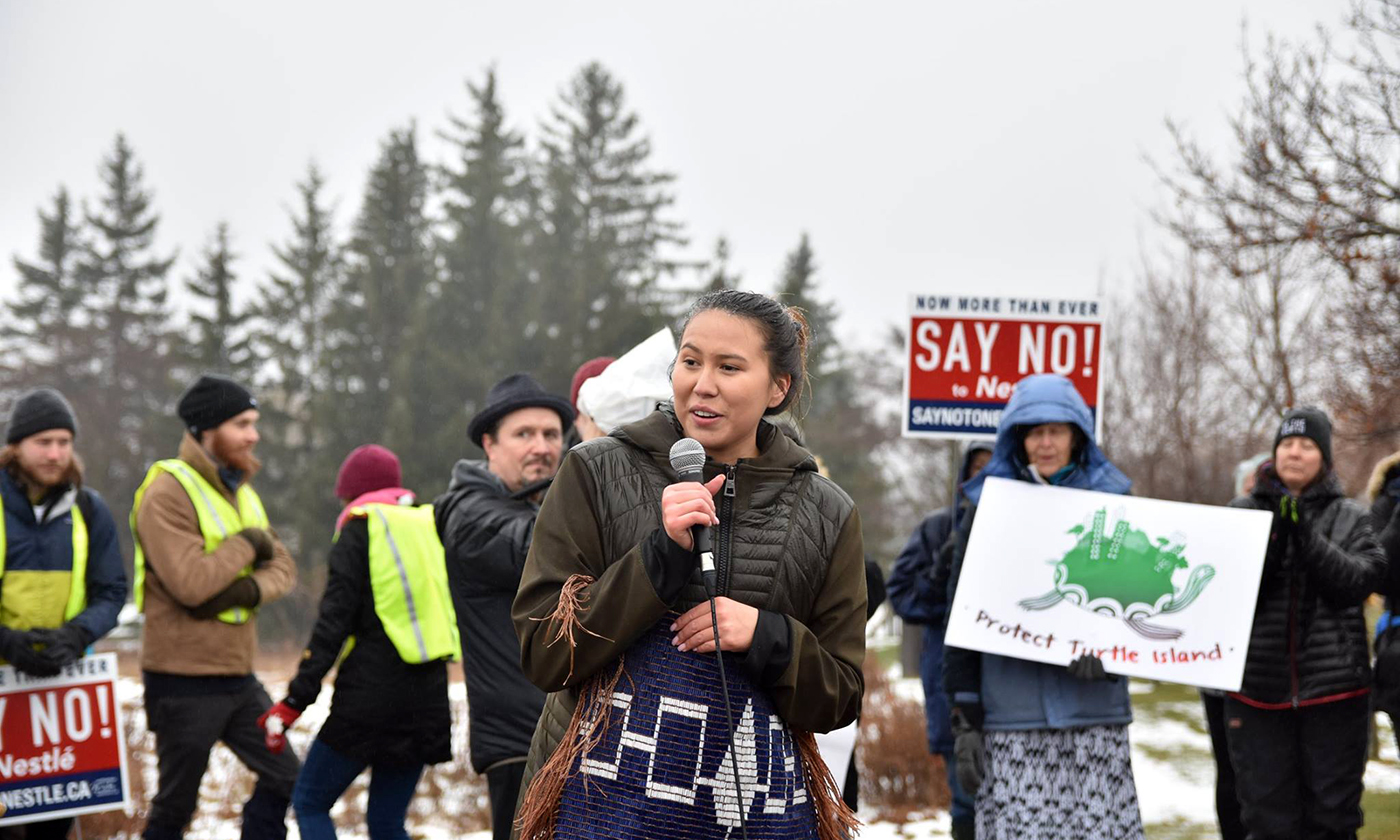Environmental Activists of Color
YES! Magazine
Young Black people, Indigenous people, and people of color at the center of environmental justice movements are often overlooked. This was evident in 2019 during Swedish teen climate activist Greta Thunberg’s whirlwind visit to the United States. Thunberg, who recently addressed world leaders at the World Economic Forum, often finds herself in the spotlight. Here are three activists of color who deserve their own spotlight.
Makaśa Looking Horse
When water activist Makaśa Looking Horse, Mohawk Wolf Clan and Lakota, in Six Nations of the Grand River, Ontario, Canada, learned that Swiss multinational food and drink corporation Nestlé was removing 4.7 million liters of water daily from her community’s aquifers without their knowledge, she had to act. “Nestlé takes the water from the land and bottles it to sell back to us. To make matters worse, they’re doing so on expired permits,” she says.
Looking Horse personally handed Nestlé’s CEO a cease and desist letter in June 2019. Her actions led to national attention, and she was invited to open for the United Nations Youth Climate Summit. “Humans must build a stronger spiritual reconnection to our mother, the Earth,” the 22-year-old water protector told her audience. “An ethical relationship with creation, a natural bond. If that existed, among all nations, we would not be facing the catastrophic crisis we are in today.”
As part of her Indigenous Studies program at McMaster University, Looking Horse is researching the poisonous water conditions on First Nations land. The water isn’t safe to drink is because it contains heavy metals like arsenic, she says. “We are in the middle of and we are surrounded by these cities, but we are still in this water crisis,” she says. “And I think that’s all part of environmental racism.” To raise awareness of the crisis and Nestlé’s role, in 2018 Looking Horse created a Day of Awareness for her community, featuring speakers and a 5-kilometer run. “Traditionally our communities had runners to carry messages to different communities,” she explains. “And so our message was to Nestlé to stop taking our water.”
Elsa Mengistu
Mengistu, a freshman at Howard University, has always cared about social justice, but when she came across the work of Zero Hour, a youth-led, nonprofit environmental justice organization, she saw for the first time climate justice framed with a lens that focused on the people affected by climate change and climate disasters, not just data and scientific jargon.
“[That] is all great,” Mengistu says about the technical focus, “but it doesn’t get to the root of the problem, which is people and the chaos that climate crisis creates, and how that manifests in our everyday lives and in conjunction with other injustices.”
The youth activist has worked with Zero Hour for the past two years, in various roles. She describes planning a large-scale summit to train 350 youth ambassadors to be climate leaders in their local communities. “Our focus there is to give entry points and resources into climate activism,” Mengistu says. She also works with the Power Shift Network, planning a 4,000-person conference in order to train and engage people who have not been in the movement, and hone the skills of people who have. “For me, the best way that I had been able to utilize my skill set is to connect people to resources,” she says. Mengistu is juggling lots while she is in her first year of university, but still sees a place for activism in her life. She has had to learn about balance within organizing spaces. “In order for us to even sustain a movement, we have to sustain ourselves,” she says.
Mari Copeny aka Little Miss Flint
In 2016, 8-year-old Amariyanna “Mari” Copeny, also known as Little Miss Flint, wrote President Barack Obama a letter about the water crisis in her hometown of Flint, Michigan. That letter, and her subsequent meeting with Obama, were the start of the now 12-year-old’s activism—and goal of being a U.S. President herself.
Little Miss Flint regularly reminds the world through her social media platforms—she has 118,000 followers on Twitter—interviews, and speaking engagements, of the Flint water crisis.
“[Mainstream environmental justice movements] don’t always focus on and amplify the voices of Black, Brown, and Indigenous youth even though we are living with the issues daily,” she says. “They need to make sure they are giving space to those voices that are so easily forgotten.”
Copeny’s message extends beyond Flint’s water. She cares about the intersecting issues of oppression and puts resources in different places. According to her website, Copeny has raised more than $500,000 since 2016, helping more than 20,000 children get clean water, school supplies, and other resources in Flint and other cities facing similar challenges.
“To the people [who] are living outside of Flint, the crisis is not over yet,” Copeny says. “But Flint is not the only city dealing with a lead water crisis, in fact, there are hundreds of other communities dealing with the exact same crisis. If we forget about Flint there is no hope for any of those other communities.”
Happy #PresidentsDay @BarackObama...my forever favorite president. #Forever44 #Copeny2044 pic.twitter.com/mFXRUKpeax
— Mari Copeny (@LittleMissFlint) February 18, 2020
Ananya Garg is a solutions journalism reporting intern for YES!, poet, and educator in Seattle.
Note: This article originally appeared on YES! Magazine. It is published under a Creative Commons license.
Join the Conversation

